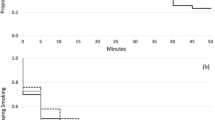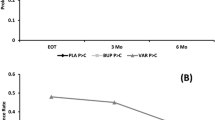Abstract
Purpose. A population pharmacokinetic-pharmacodynamic model accounting for placebo effect was used to relate nicotine concentration and enforced smoking cessation craving score measured by the Tiffany rating scale short form.
Methods. Twenty-four smokers were enrolled in a placebo-controlled, randomized, double-blind, three periods, crossover trial. The study objective was to describe the nicotine-induced changes on craving scores. Two modeling strategies based on a mechanistic (indirect response models with drug-related inhibition on the kin synthesis rate and with a drug-related stimulation of the kout removal rate were evaluated) and a probabilistic (logistic regression) approach were used.
Results. Placebo response model properly fitted the circadian changes on craving scores. The analysis revealed that the indirect response model with inhibition on kin was the preferred model for the smoking data whereas the preferred model for the Nicotine Replacement Therapy data was the one with stimulation on kout. The logistic analysis showed that the nicotine concentration was a significant predictor of reduction in craving during the free-smoking period.
Conclusions. Nicotine dosage regimen can influence the nicotine mechanism of action: an instantaneous delivery at an individually selected time seems to inhibit the onset of craving while constant delivery at a pre-defined time seems to attenuate the craving.
Similar content being viewed by others
REFERENCES
US Centers for Diseases Control and Prevention. Cigarette smoking among adults—United States 1993. MMWR 43:925-929 (1994).
J. L. Tang, M. Law, and N. Wald. How effective is nicotine replacement therapy in helping people to stop smoking? BMJ 308:21-26 (1994).
M. C. Fiore, S. S. Smith, D. E. Jorenby, and T. B. Baker. The effectiveness of the nicotine patch for smoking cessation: A meta-analysis. JAMA 271:1940-1947 (1994).
S. T. Tiffany and D. J. Drobes. The development and initial validation of a questionnaire on smoking urges. Br. J. Addiction 6:1467-1476 (1991).
K. O. Fagerstrom. Measuring degree of physical dependence to tobacco smoking with reference to individualization of treatment. Addict. Behav. 3:235-241 (1978).
W. J. Jusko and H. C. Ko. Physiologic indirect response models characterize diverse types of pharmacodynamic effects. Clin. Pharmacol. Ther. 56:406-419 (1994).
J.-M. Gries, N. Benowitz, and D. Verotta. Chronopharmacokinetics of nicotine. Clin. Pharmacol. Ther. 60:385-395 (1996).
N. L. Dayneka, V. Garg, and W. J. Jusko. Comparison of four basic models of indirect pharmacodynamic responses. J. Pharmacokin. Biopharm. 21:457-478 (1993).
S. L. Beal, L. B. Sheiner. NONMEM User's Guide, University of California at San Francisco, San Francisco, CA, 1992.
H. Bozdogan. Model selection and Akaike's information criterion (AIC): The general theory and its analytical extensions. Psychometrika 52:345-370 (1987).
K. J. Schuh and M. L. Stitzer. Desire to smoke during spaced smoking intervals. Psychopharmacology (Berlin) 120:289-295 (1995).
N. G. Sneider, M. E. Jarvik, and A. B. Forsythe. Nicotine vs. placebo gum in alleviation of withdrawal during smoking cessation. Addict. Behav. 9:149-156 (1984).
M. E. Jarvik, D. C. Masden, R. E. Olmstead, P. N. Iwamoto-Schaap, J. L. Elins, and N. L. Benowitz. Nicotine blood levels and subjective craving for cigarettes. Pharmacol. Biochem. Behav. 66:553-558 (2000).
J. V. S. Gobburu and W. J. Jusko. Role of dosage regimen in controlling indirect pharmacodynamic responses. Adv. Drug Deliv. Rev. 33:221-233 (1998).
Author information
Authors and Affiliations
Rights and permissions
About this article
Cite this article
Gomeni, R., Teneggi, V., Iavarone, L. et al. Population Pharmacokinetic-Pharmacodynamic Model of Craving in an Enforced Smoking Cessation Population: Indirect Response and Probabilistic Modeling. Pharm Res 18, 537–543 (2001). https://doi.org/10.1023/A:1011070814530
Issue Date:
DOI: https://doi.org/10.1023/A:1011070814530




